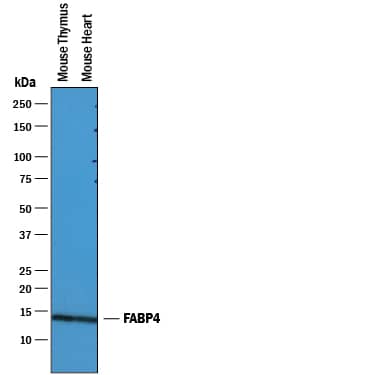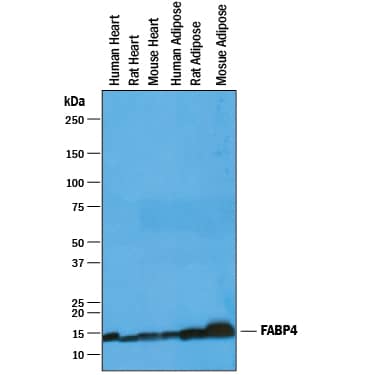FABP4/A-FABP Products
Fatty Acid Binding Protein 4 (FABP4), also known as A-FABP and aP2, is the predominant FABP found in adipocytes and is often used as a marker for adipocyte differentiation. It is also expressed in macrophages, dendritic cells, and endothelial cells. FABP4 is a key mediator of intracellular fatty acid transport and metabolism in adipose tissue. Its expression is regulated by multiple factors including fatty acids, PPAR gamma agonists, and Insulin, and its levels increase with lipolytic stimulation. It can increase the hydrolytic activity of Hormone-Sensitive Lipase and increase the production of proinflammatory cytokines and chemokines. FABP4 upregulation in adipocytes and macrophages is associated with the development of Insulin resistance, hypertriacylglycerolaemia, and atherosclerosis. Serum levels of FABP4 are elevated in obesity and metabolic syndrome, type 2 diabetes, HIV-associated lipodystrophy, polycystic ovary syndrome, nonalcoholic fatty liver disease, atherosclerosis, and acute ischaemic stroke. FABP4 is also overexpressed in multiple cancer types including ovarian, bladder, glioblastoma, and oral, and it may play a role in tumor progression.
52 results for "FABP4/A-FABP" in Products
52 results for "FABP4/A-FABP" in Products
FABP4/A-FABP Products
Fatty Acid Binding Protein 4 (FABP4), also known as A-FABP and aP2, is the predominant FABP found in adipocytes and is often used as a marker for adipocyte differentiation. It is also expressed in macrophages, dendritic cells, and endothelial cells. FABP4 is a key mediator of intracellular fatty acid transport and metabolism in adipose tissue. Its expression is regulated by multiple factors including fatty acids, PPAR gamma agonists, and Insulin, and its levels increase with lipolytic stimulation. It can increase the hydrolytic activity of Hormone-Sensitive Lipase and increase the production of proinflammatory cytokines and chemokines. FABP4 upregulation in adipocytes and macrophages is associated with the development of Insulin resistance, hypertriacylglycerolaemia, and atherosclerosis. Serum levels of FABP4 are elevated in obesity and metabolic syndrome, type 2 diabetes, HIV-associated lipodystrophy, polycystic ovary syndrome, nonalcoholic fatty liver disease, atherosclerosis, and acute ischaemic stroke. FABP4 is also overexpressed in multiple cancer types including ovarian, bladder, glioblastoma, and oral, and it may play a role in tumor progression.
| Reactivity: | Mouse, Rat |
| Details: | Goat IgG Polyclonal |
| Applications: | WB, Simple Western, IHC, ICC |
| Reactivity: | Human |
| Details: | Goat IgG Polyclonal |
| Applications: | WB, Simple Western, ELISA, IHC |
Recombinant Monoclonal Antibody
| Reactivity: | Human |
| Details: | Mouse IgG1 kappa Monoclonal Clone #rFABP4/8536 |
| Applications: | IHC |
| Sensitivity: | 14.2 pg/mL |
| Applications: | ELISA |
| Assay Range: | 62.5 - 4,000 pg/mL (Cell Culture Supernates, Cell Lysates, Serum, EDTA Plasma, Heparin Plasma) |
| Reactivity: | Human |
| Details: | Mouse IgG1 kappa Monoclonal Clone #FABP4/4422 |
| Applications: | IHC, MA |
| Reactivity: | Human |
| Details: | Mouse IgG1 kappa Monoclonal Clone #FABP4/4422 |
| Applications: | IHC, MA |
Recombinant Monoclonal Antibody
| Reactivity: | Human |
| Details: | Rabbit IgG Kappa Monoclonal Clone #FABP4/8537R |
| Applications: | IHC |
Recombinant Monoclonal Antibody
| Reactivity: | Human |
| Details: | Mouse IgG1 kappa Monoclonal Clone #rFABP4/8536 |
| Applications: | IHC |
Recombinant Monoclonal Antibody
| Reactivity: | Human |
| Details: | Mouse IgG1 kappa Monoclonal Clone #rFABP4/8536 |
| Applications: | IHC |
Recombinant Monoclonal Antibody
| Reactivity: | Human |
| Details: | Rabbit IgG Kappa Monoclonal Clone #FABP4/8537R |
| Applications: | IHC |
| Reactivity: | Human, Mouse, Rat |
| Details: | Rabbit IgG Polyclonal |
| Applications: | IHC, WB, Simple Western |
Recombinant Monoclonal Antibody.
| Reactivity: | Human, Mouse, Rat |
| Details: | Rabbit IgG Monoclonal Clone #JM10-99 |
| Applications: | IHC, WB, ICC/IF |
| Reactivity: | Human, Mouse |
| Details: | Rat IgG1 Monoclonal Clone #804914 |
| Applications: | WB, ELISA |
| Reactivity: | Mouse |
| Details: | Goat IgG Polyclonal |
| Applications: | WB, IHC |
| Assay Range: | 62.5 - 4,000 pg/mL |
| Applications: | ELISA |
| Reactivity: | Human, Mouse |
| Details: | Rabbit IgG Polyclonal |
| Applications: | IHC, WB, ELISA, ICC/IF |
| Source: | E. coli |
| Accession #: | P04117 |
For use with catalog number DFBP40
| Applications: | ELISA, Ctrl |
| Applications: | ELISA |
| Applications: | ELISA |
| Applications: | AC |
Recombinant Monoclonal Antibody
| Reactivity: | Human |
| Details: | Rabbit IgG Monoclonal Clone #001 |
| Applications: | IHC, Flow |
Recombinant monoclonal antibody expressed in HEK293F cells
| Reactivity: | Human |
| Details: | Rabbit IgG Monoclonal Clone #1H4 |
| Applications: | ELISA |
Recombinant Monoclonal Antibody
| Reactivity: | Human |
| Details: | Rabbit IgG Monoclonal Clone #001 |
| Applications: | IHC, Flow |
Recombinant Monoclonal Antibody
| Reactivity: | Human |
| Details: | Rabbit IgG Monoclonal Clone #001 |
| Applications: | IHC, Flow |






![Immunohistochemistry-Paraffin: FABP4/A-FABP Antibody [NBP1-89218] Immunohistochemistry-Paraffin: FABP4/A-FABP Antibody [NBP1-89218]](https://resources.bio-techne.com/images/products/FABP4-A-FABP-Antibody-Immunohistochemistry-Paraffin-NBP1-89218-img0016.jpg)
![Western Blot: FABP4/A-FABP Antibody (JM10-99) [NBP2-66828] Western Blot: FABP4/A-FABP Antibody (JM10-99) [NBP2-66828]](https://resources.bio-techne.com/images/products/FABP4-A-FABP-Antibody-JM10-99-Western-Blot-NBP2-66828-img0005.jpg)


![Immunocytochemistry/ Immunofluorescence: FABP4/A-FABP Antibody [NBP1-33616] Immunocytochemistry/ Immunofluorescence: FABP4/A-FABP Antibody [NBP1-33616]](https://resources.bio-techne.com/images/products/FABP4-A-FABP-Antibody-Immunocytochemistry-Immunofluorescence-NBP1-33616-img0006.jpg)

![ELISA: Mouse FABP4/A-FABP ELISA Kit (Colorimetric) [NBP2-82410] - Mouse FABP4/A-FABP ELISA Kit (Colorimetric)](https://resources.bio-techne.com/images/products/nbp2-82410_mouse-fabp4-a-fabp-elisa-kit-colorimetric-132202416243435.jpg)
![ELISA: Rat FABP4/A-FABP ELISA Kit (Colorimetric) [NBP2-82484] - Rat FABP4/A-FABP ELISA Kit (Colorimetric)](https://resources.bio-techne.com/images/products/nbp2-82484_rat-fabp4-a-fabp-elisa-kit-colorimetric-132202416175654.jpg)